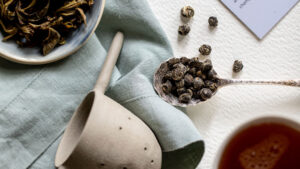Tea growing and production
Before we unpack the incredible process of tea growing and production, we first must introduce what exactly are these tea leaves hidden in our tea bag…
To summarise, all tea leaves whether they be green, black, white or yellow – all derive from the same plant called Cammelia Sinensis. What differs between the teas, is how they’re processed. For example, tea leaves are exposed to air (oxidisation) for black tea whereas, for green tea they’re not. For a detailed description on tea, read further in our blog What Is Tea?
The Camellia Sinensis plant is an impressive shrub that has gifted us with an incredible array of tea varieties. Farmers across the globe have experimented with the plant, uncovering new and delicious ways of farming tea leaves. The result has been awe inspiring. You only need to stroll past the tea section in a supermarket to see the great variety on offer.
Tea growing
Tea growing isn’t as simple as growing herbs in your backyard (although, that in itself can be a challenge!). Harvesting tea is a similar complexity to growing coffee. Anyone can grow a coffee tree in their backyard however, depending on the climate, soil and care the coffee tree receives will greatly change the quality of the coffee.
With Australia’s dry and hot climate and naturally saline soil, unfortunately this means tea (and coffee) growing isn’t ideal. However… This hasn’t stopped our love for tea with Australians drinking an average of 9.5 cups per person per week!
Tea growing regions
The most popular tea growing regions are Asia, Africa, South America, and in the Black and Caspian Seas. Within these regions, the four biggest tea producing countries are China, India, Sri Lanka and Kenya.
Tea produced per annum (metric tonnes):
- China: 2,400,000 (40% of the world’s tea)
- India: 900,000
- Kenya: 305,000
- Sri Lanka: 300,000
What makes these tea regions unique and sought after is a combination of their tropical climate, rich and healthy soil as well as their great experience and knowledge of growing tea. It’s no surprise that China comes in first place with production, considering that they’re in fact the birthplace of tea! History records China producing tea more than 2,000 years ago… that’s a long time to understand and perfect the art of growing tea.
Ideal climate
If you’re an avid gardener, you will know just how tricky it can be to match the veggies you plant with the weather and climate… especially as these seasons merge and blur.
The climate plays an important role in growing all types of flora. For plants you’re going to eat and drink, you can notice instantly a plant that is grown in correct conditions versus one that is grown under a harsh climate. For tea growing, this is even more specific and intricate.
Tea thrives in rainy regions at altitudes of 2,000 to 7,000 feet in the heated tropics and lower elevations in the cooler temperate regions (south- east, south and south-west of the continent).
Ideally, weather that is hot during the day and cool during the night will provide the best growing environment for tea cultivation. This combination of hot days/cool nights promotes plant growth during the day whilst slowing the growing process at night.
Best soil for tea growing
The well known phrase “you are what you eat” although often applied to human health, can also be applied to plants, veggies and (of course) tea!
The soil is what the tea plants rely on for nutrients to grow big and strong. Soil is just as important as the climate, with different soil compositions impacting the flavour of the end cup of tea.
Tea plants grow best in acidic soil that has a pH between 4.5 and 5.5 and that is rich in calcium, magnesium, and nitrogen. Regions that are renowned for great soil are areas with high elevation. Often tea will be grown on mountain-sides or around volcanoes specifically because of their nutrient-dense soil.
For areas that aren’t as lucky to have rich and healthy soil, often fertilisers will be used. Japanese tea farms are renowned for using a natural fertiliser made of grass, which you can taste in many teas sourced from Japan.
Fun fact: the soil around volcanoes is so impressive that it’s a sought after location for both tea and coffee growing.
Tea production
Once the tea leaves have been grown, tea farmers then begin processing the tea leaves. How the tea farmer chooses to process the tea leaves will ultimately determine the quality of the type of tea that’s produced.
The steps to processing tea are as follows: plucking, wilting, leaf maceration, oxidation, fixation, rolling, drying and curing. These steps of tea processing can alter depending on the type of tea being processed as well as the farmer’s technique.
It’s more than a cup of tea
Tea is as common as water. Look in any individual’s cupboard and the chances are there will be a box or jar of delicious tea waiting to be drunk. When you discover the amount of attention and care that’s given to the tea leaves, it’s no wonder why the world has fallen in love with this beverage (including us!).
From the soil the tea plants grow in, to the sun that shines down on the plants, every step of growing the tea contributes to the quality of that end cup. As you prepare and enjoy your next cuppa, we hope you savour each sip, enjoying the natural nuances in the brew.






